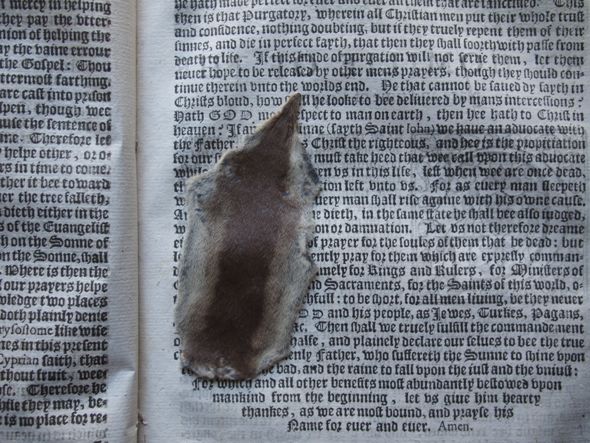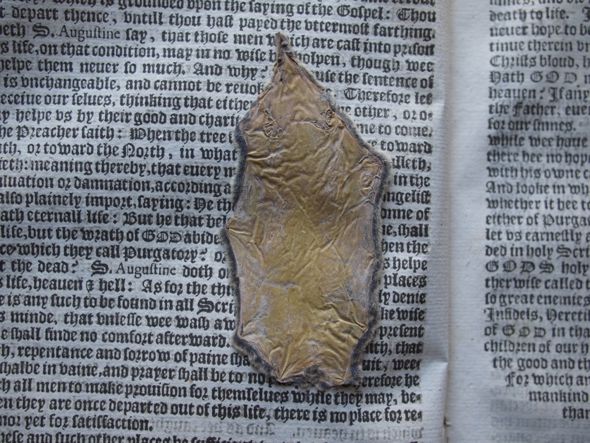Surface cleaning an entire book can evoke a range of emotions, from mind numbingly boring, to mind numbingly repetitive, to mind numbingly tedious. The problem is that you have to remain acutely aware of tiny changes in the paper surface, dirt composition, tears, soiling, stains, etc. to avoid damaging the pages. After hundreds of pages (hours of cleaning) of back and white text, I almost fell over when I suddenly saw colored fur.
Certaine Sermons or Homilies appointed to be read in Churches…. London: Printed by John Bill, 1623. Collection David Kastan. Top: Hair on mouse skin. Bottom: detail of the flesh side. Why did someone put it in this book?
In section 3, on page 123, I found the remains of a very cute mouse. When I inspected it, it appeared tanned with the hair on, the tail and legs removed. Even more oddly, it was not causing any staining or damage, so I left it in place. The homilie where the mouse was found is titled “Concerning Prayer”, and for the curious, there are no textual rodent references on the adjacent pages. It is difficult to believe that this was an accident, and there were half a dozen other more usual items put into this book: leaves, ferns, seeds, scraps paper with notes. It is tempting to concoct a story why the mouse was put there: possibly as an alert from a teacher to see if the student was actually reading these dry sermons? A wake up call? A reminder of the inevitability of death for living things, as compared to the longevity of the written word?



The forerunner of a bookmark – a bookmouse??
A former colleague once found a slice of wedding cake between the leaves of a scrapbook she was treating. Honestly, I don’t know what would be worse: finding a mouse pelt or a crumbly, dried-out piece of cake.
That really takes the cake.
Since we’re geting silly, perhaps the mouse was being used to help guide the eyes/cursor… PARC had nothing on these ancient ones.
Maybe it’s just prescient; run your mouse over the text for more information, it’s just there’s no wi-fi connection to wikipedia
The mouse pelt appears to have been carefully prepared for some purpose. I have just found a few references on the web to mouse fur being used historically to make false eyelashes which may explain this find.
“It is difficult to believe that this was an accident, and there were half a dozen other more usual items put into this book: leaves, ferns, seeds, scraps paper with notes.”
I think you have simply found the book of a naturalist who used it to press “treasures.” The written content was probably of no significance – simply the fact that it was a large volume with enough size and weight to do a good job of flattening. I have many books full of items from nature & I would hate to think any future discoverers wasted time trying to figure out the significance between the book/text and what was inserted. (I also have a perfectly dried shrew stuck on a bulletin board in my hallway that is there for no reason other than it is out of the dog’s reach and I know where it is.) We naturalists are an odd lot!
Reblogged this on lauracaradonna and commented:
I’m repairing the same book from the Townend library: how odd!
Small world! Is there a mouse in it? Cheers, Jeff
I’m happy to say there’s no mouse in it! Ciao, Laura